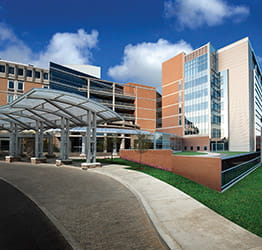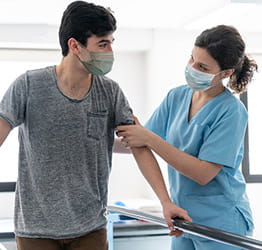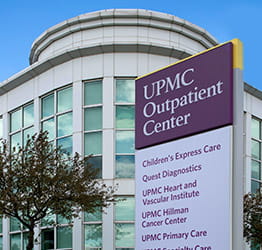Sight-Saving Brain Tumor Surgery, Close to Home: Veronica’s Story
In November 2024, Veronica D., 43, of North Sewickley Township, Pa., started noticing a black dot in her left eye. At first, she didn't feel concerned.
“I went to my optometrist, and they explained that eyes deteriorate over time and gave me a prescription for bifocals,” Veronica says.
But by the end of the year, she had lost sight completely in her left eye. By January 2025, the same symptoms were beginning in her right eye. She wondered if something else was going on.
“It didn’t feel like my eyes were going bad,” she says. “It felt like something bigger was happening.”
That’s when Veronica visited a retinal specialist in Warrendale, Pa., who didn’t waste any time in transferring her to the Urgent Eye Care Clinic at the UPMC Vision Institute.
There, imaging scans and an MRI revealed a meningioma — a benign (noncancerous) tumor at the base of Veronica’s skull, called the tuberculum planum. The tumor was pressing on her pituitary gland and optic nerves, cutting off her vision and causing unbearable headaches.
From there, Veronica was quickly transferred to UPMC Presbyterian, where doctors explained their plan to remove the tumor. They recommended a minimally invasive endoscopic endonasal approach (EEA) surgery as soon as possible.
Minimally Invasive Skull-Based Surgery
EEA is a minimally invasive surgery done through the nostrils and sinus cavities to reach and remove tumors at the base of the skull. UPMC neurosurgeons pioneered and refined this technique for brain surgery over 25 years ago. More than 5,000 patients have received brain tumor removal surgery using EEA at UPMC.
EEA has several benefits. It doesn’t create any incisions, has a shorter recovery time, and poses less risk of damaging brain tissue.
“I’m not someone who panics very easily,” Veronica says. “It was very alarming to receive all of this news. But I had a peace about me.”
A big part of Veronica’s peace came from her conversation with brain tumor neurosurgeon and skull base surgery expert Georgios Zenonos, MD, before surgery.
“He pulled up a chair and talked to me like I was a family member,” Veronica says. “He explained everything with a smile on his face, answering all my questions with a kind and compassionate voice.”
Another part of Veronica’s peace came from the prayers she could feel from her family, friends, and church community.
A Different Path to Brain Tumor Removal
With Veronica confident and calm, Dr. Zenonos and his team performed a successful EEA meningioma resection in February 2025, removing the entire tumor through her nostrils. After a few days in the neurosurgical intensive care unit at UPMC Presbyterian, Veronica went home to recover.
“My only concern was the postsurgery recovery period,” Veronica says. “I was nervous about that, about the pain.”
Veronica spent the first two months after surgery sleeping on the couch in an elevated position. She packed her nose with four bulky gauze wads and had to learn how to sneeze through her mouth. Moving and communicating during that time was hard, and she had to rely on her community in a new way.
Veronica was grateful to have help from all over.
Her mother flew in from Dallas and made her traditional medicinal foods from their original country of Zambia.
Her husband slept on the couch next to her and helped administer her medication and feed her fruit and popsicles.
Friends dropped by to keep her company, and her sisters visited from out of town.
Her 16-year-old son stayed by her side.
“A month in, it hit me — the trauma and everything,” Veronica says. “I burst out crying, thinking of what would have happened to my son if something bad had happened to me. I feel so blessed to have been at the right place at the right time.”
Another troubling time came when Veronica looked in the mirror and saw that her left eye was looking left and her right eye was looking up.
‘“Please, God, fix these lazy eyes,’ I prayed,” says Veronica. With time and patience, her eyes finally came together and began looking straight on.
Doctors had warned Veronica that her sight might not return for six months. However, six weeks after surgery, her right eye began regaining its sight. Slowly, the left did as well.
At her second eye appointment weeks later, her doctors happily informed Veronica she was no longer legally blind. Her right eye had 20/20 vision, while her left eye had 20/25 vision. She continues to slowly regain her peripheral vision, and although she can’t drive at night yet, she remains hopeful.
Continued Care and Blessings
Veronica also continues follow-up appointments with sinus and skull base surgery specialist Garret W. Choby, MD.
“It's a tremendous relief to finally have this issue resolved,” she continues. “For years, I suffered from excessive headaches, unexplained hormonal imbalances, unpredictable weight gain, frequent and abnormal periods, adult acne, fatigue, and persistent brain fog. I assumed these symptoms were a part of getting older. I never realized that my pituitary gland was affected by the tumor."
“I believe in miracles,” she adds, thinking of the other big miracle in her life — her son, born despite her endometriosis diagnosis years ago. “I’m being very patient with this, too.”
Through it all, Veronica is thankful that the right doctors were in the right place to perform this complex surgery — and they were so close to her home.
“I can’t say enough nice things about how these doctors have taken care of me,” Veronica says. “I remember calling my mom and saying: ‘I’m going to be OK. I talked to the nicest doctor in the world. He’s not like any other doctor I’ve met. He got my husband to give him a hug.’
“I’m so thankful, so blessed to have been in Dr. Zenonos’ and Dr. Choby’s care.”
Veronica’s treatment and results may not be representative of all similar cases.

















